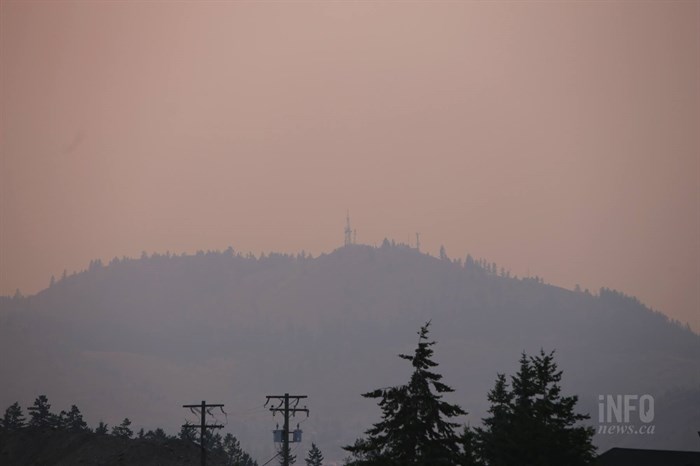
Image Credit: FILE PHOTO
June 22, 2018 - 3:10 PM
KAMLOOPS - As wildfires ignite across the province, one professor at Thompson Rivers University says people need to be aware of the health risks associated with short-term exposure to high levels of air pollution.
Michael Mehta, a professor of geography and environmental studies at TRU, says it’s not just long-term exposure to poor air quality that can pose health risks. Short-term exposure can have serious health consequences depending on an individual’s health status.
“There’s very strong emerging consensus in scientific literature showing that short-term exposure to pollution is very important to keep track of, and for people to minimize their exposure.”
Mehta, who has also launched his own air quality monitoring system throughout the city, explains that even short-term exposure can cause serious cardiopulmonary concerns.
“When people are exposed to short-term high levels of air population if they have any kind of problems with plaque build-up in their arteries when they are exposed to a sudden increase in air pollution it can create an inflammatory response to the arteries,” Mehta says.
When this happens it can result in the walls of the arteries having a spasm and could typically cause a stroke, he explains.
“So stroke is actually the most likely outcome for people who are older with probably, well, almost all of us have some kind of arterial build-up as a result of (short) exposure,” he says.
But what defines short-term exposure is hard to explain.
“The definition of short and long is somewhat arbitrary,” he says. “It’s not like we are talking about a year versus a minute so it’s a highly debated question of what constitutes as long and what constitutes as short and that primarily depends on the individual.”
Mehta says more air quality monitors would help keep track of short-term air pollution to better inform people when to avoid outdoor pollution when possible. There is currently one provincial air monitor in the city and although the readings are of good quality, Mehta says, having one is not enough.
"With such a complex geography, topography and meteorology we typically have in Kamloops and the region, we have different airsheds," he says. "We don't have just one pool of air drawn and I believe having just one very high-resolution good quality air station isn't sufficient."
Mehta says his air monitoring systems PurpleAir and Sensor Up reflect accurate real-time data for people when they are in a certain area. Mehta says with his monitors, and more provincial air monitors, more accurate readings could be provided.
"Due to the cost not only of the (provincial) equipment but also the labour to maintain it and to verify the accuracy of that data, (the Ministry of Environment and Interior Health) may argue that one is sufficient and I think that's not the right way to go," he says. "We have this low-cost technology, it's definitely not as accurate as the provincial monitor but would supplement the provincial monitor to work together."
Coun. Donovan Cavers presented a notice of motion at a regular council meeting earlier this month proposing the city install air monitoring systems with PurpleAir to municipal buildings. If the proposal is approved, the maximum budget for the air monitoring systems would be $2,000. The motion has since been deferred for city staff to work with PurpleAir officials to determine the accuracy of the air monitoring readings.
A wildfire that ignited just north of Kamloops’s Batchelor Height’s neighbourhood on June 21 filled the area with heavy smoke which could be seen from various locations across the city. Mehta says the air quality has since stabilized but residents should be cautious of the amount of time they spend outdoors when the air quality is low because of a wildfire.
“One of the things that people said since (the wildfires) last summer, and I've heard it several times, is that these are natural events and 'what are we supposed to do about it,'” he says. “They kind of take a little bit of a cavalier attitude or a cowboy attitude to it that we’ll just suck it up and deal with it and continue as usual.”
But that shouldn’t be the case, he says.
“People need to recognize that this is a serious situation, they need to reduce their exposure to outdoor pollution and they need to watch very carefully with their children, we need to have our windows closed and we need to be pre-emptive,” he says. “This is probably going to become the new normal now for Kamloops and people need to be aware."
Mehta says wearing N95 masks can be effective when they are fit properly and also recommends people use HEPA filters in the home to help trap pollutants.
"(People) need to think very carefully about putting themselves in harms way in events that may transpire over the summer months when the air pollution levels are really high, so it is a wakeup call," he says.
To contact a reporter for this story, email Karen Edwards or call (250) 819-3723 or email the editor. You can also submit photos, videos or news tips to the newsroom and be entered to win a monthly prize draw.
We welcome your comments and opinions on our stories but play nice. We won't censor or delete comments unless they contain off-topic statements or links, unnecessary vulgarity, false facts, spam or obviously fake profiles. If you have any concerns about what you see in comments, email the editor in the link above.
News from © iNFOnews, 2018